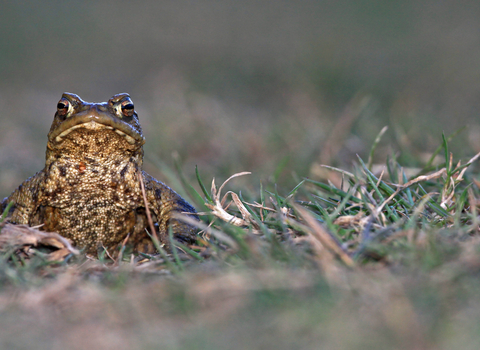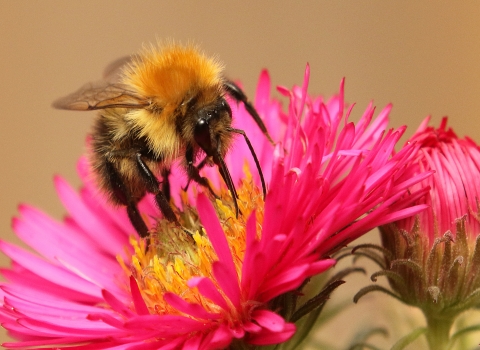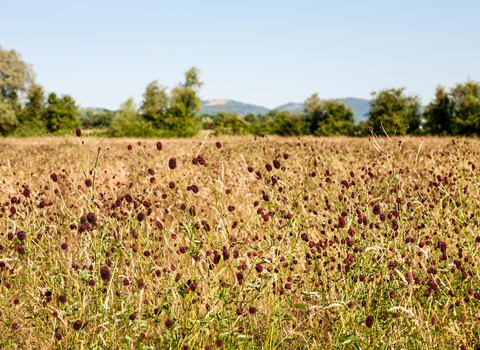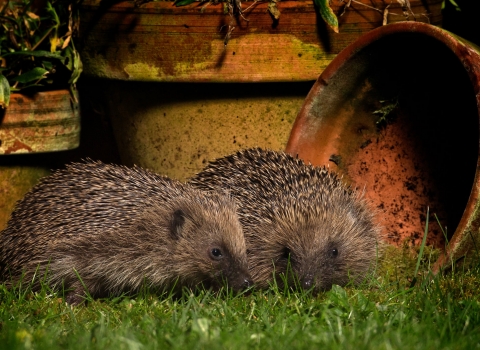Help us to learn more about our wildlife
Delighted by the sparrows in your garden? Ever bimbled behind a bumble from flower to flower? If so, we need your help.
Sightings of wildlife in our beautiful county are held by Worcestershire Biological Records Centre (WBRC). By tracking distribution, abundance and when wildlife is seen, we can learn more about how species are doing and whether changes to our environment, from land use to climate change, are having an impact.
Together with WBRC, we've teamed up with the Worcestershire Recorders, a volunteer group dedicated to recording sightings of Worcestershire's wildlife, to find out more about the stories behind the species and the records.
Submit a sighting of wildlife you've spotted
We're specifically looking for sightings of 15 species; most of which can be found in your garden or local neighbourhood. We've explained a bit more about each of them underneath the form below. We'll need a photograph to help us verify your sighting so that it can be officially logged.
Need help with identifying wildlife?
We're more than happy to help you identify Worcestershire's wildlife. Some wildlife can be identified from a fuzzy photo but we'll need a bit more information for other species. In some instances this could be a photo from above, front and side. For others, it could be information about what plant you found it on. Please upload any photos, videos or audio along with more information and we'll do our best to identify your mystery wildlife.
If you'd like to see what's been spotted so far, scroll down the page and take a look at our map.
Have you seen me?
We're happy to receive records of all wildlife but are particularly interested in hearing about the following species. Members of the Worcestershire Recorders, the go-to people to help identify and record wildlife in the county, have provided more information about these fascinating creatures below. Please use the form above to let us know if you spot any of them.
Batman hoverfly
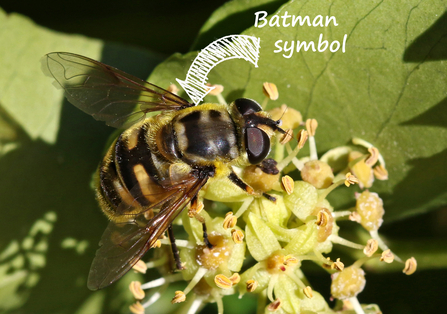
Batman hoverfly by Wendy Carter
Batman hoverflies Myathropa florea are one of our most commonly encountered hoverflies (there are over 280 species in the UK). You might be forgiven for mistaking this hoverfly for ones that superficially look a little similar but this wasp mimic has a distinctive mark that's not only recognisable but also means that you'll remember its name! The black mark at the base of the thorax where the wings meet the body resembles the 'Batman' symbol. The spring generation tends to be a bit of a dull yellow but the summer generation are usually very bright. Once you get your 'ear in' you might also notice that they have quite a distinctive buzz.
Whilst these are quite common hoverflies across Worcestershire, changes in our weather means that we'd like your help to enable us to track how they're doing. Their larvae develop in holes and crevices within trees that fill with water and wet detritus. They've also been known to develop in buckets and even damp compost heaps and soil. With increasingly dry summers, we'd like to track their fortunes to see if and how changing weather patterns affects their abundance or distribution.
Not only can you look out for and report these super hero pollinators, you can also give them a helping hand by replicating the kind of rot hole conditions that the females like to lay their eggs into. Why not create a hoverfly lagoon in your garden...and watch what develops and emerges.
Box-tree moth
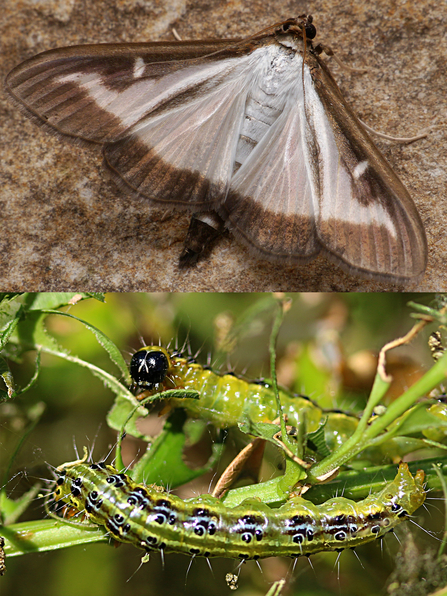
Box-tree moth adult and larvae by Oliver Wadsworth and Nick Goodrum
Native to China, Japan and Korea, box-tree moths were first recorded in the UK in 2008, probably as a result of an accidental introduction through the horticultural trade. The species initially spread through the southeast of England but by 2018 it had reached Scotland.
The larvae make conspicuous silken webbing, in which they feed, on box Buxus sempervirens (it’s also been found on Japanese spindle Euonymus japonica). Their presence can result in the complete stripping of a box plant (or even hedge). As well as being conspicuous, the larvae are distinctive – black heads and green bodies with black and white marks.
The adults with brown-edged ivory-white wings (although there is also a less common darker form), can be seen flying from June to October. If you have box in your garden, it’s worth keeping a lookout for them. They overwinter as small larvae.
Box-tree moths were first recorded in Worcestershire in Malvern in 2017. There are still fewer than 20 records for the county and all the sightings have been of adult moths. They’re known from Redditch, Bewdley, Stourport and Worcester. Can you help us to fill in the blanks and help us to track their spread?
Broad-bodied chaser
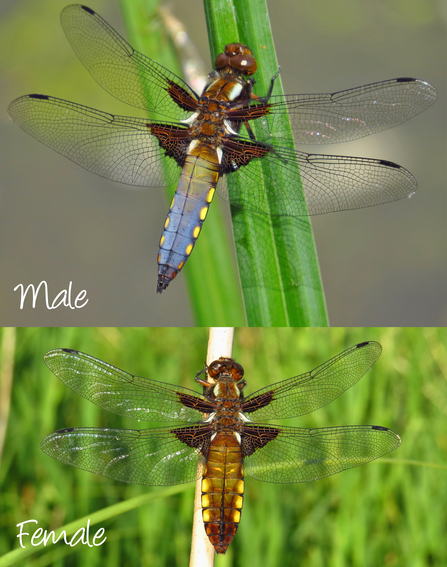
Broad-bodied chaser by Mike Averill
If you had never seen a broad-bodied chaser before, you might think a hornet had just landed by your pond. A closer look will show that it is a stocky-looking dragonfly with a flattened broad abdomen and four similarly sized wings, each with a dark patch at their base.
Females have a yellowish-brown abdomen and tend to be less obvious but may be seen quickly flying in to lay eggs by stroking the water surface with their tail end. The male, which has a pale blue abdomen, is more conspicuous because it will repeatedly return to a perch from which it surveys the pond. You might see a male hovering near the female as she lays eggs but the two never remain attached during the process like common darters do.
These dragonflies are great colonists and are often the first to arrive at a newly dug pond. They don’t seem to like heavily vegetated water bodies and tend to visit ponds less as they get more overgrown.
Suiting their exploratory nature, they can complete their life-cycle in one year on ponds, the larvae living partially buried in silt and debris. In fact, the larvae can tolerate some drying out of the water, which helps when colonising new sites.
If you’ve got broad-bodied chasers on your pond and are trying to snap a photo of one to submit with your record, why not put a perching stick near the edge of your pond in the sun and wait to see if anyone claims it.
Will you help us to learn more about favourite habitats of broad-bodied chasers in Worcestershire?
Common carder bee
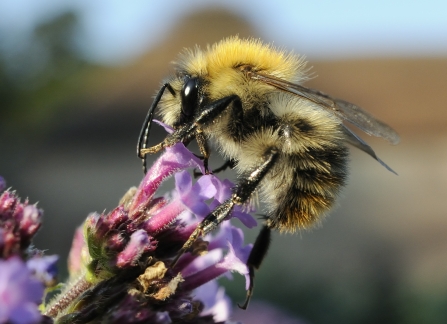
Common carder bee by Nick Upton/2020VISION
Common carder bees are one of our most common bumblebees and one of the most easily recognisable garden visitors. These gingery bees can be seen in many gardens, feeding on all sorts of flowers from rosemary and white dead-nettle in the spring to scabious in the autumn; their long tongues allow them to access tubular flowers. Unlike many species of bee, the queens, workers and males look similar to each other - all are gingery but the amount of ginger can vary and they can even fade to grey as summer wears on. Typically, their thorax is gingery and their abdomens also have a gingery look although the latter can be darker or paler depending on individual bees.
Common carder bees usually nest above ground, tucking themselves into the base of long grass or scrubby vegetation - it's important to leave some scruffy areas of your garden to help these bees. Their nests have up to 200 workers whose role it is to find pollen to bring back to feed to the young bees. They get their name from their ability to 'card' (comb) moss and grass with their mouths and legs to provide cover for their nest and egg cells.
Queen common carder bees usually emerge in spring and establish their nests soon after. It takes a while for a nest to get up 'full strength' and August is often the peak month for this species although nests can last into autumn. As the nest comes to its end, the queen starts to lay the eggs that develop into males and new queens - it's the new queens that will find a place to hibernate before emerging the following year. We'd love to know where common carder bees are, what they're feeding on where you live and whether August is still the peak month for seeing them.
Just a small note of caution. There are two other, very similar, gingery carder bees - brown-banded and moss carder bees. Brown-banded carder bees are increasing in number across Worcestershire whilst moss carder bee has not been seen in the county for many years. Separating faded individuals of common and brown-banded carder bees later in the year can be tricky but a good photograph will certainly help us.
Common toad and spawn
Common toad by Julia Saunders
In late winter and early spring toads head from their hibernation grounds to their breeding ponds to find a mate. More than 80% of toads return to the pond in which they were born, usually an older and deeper pond than those chosen by frogs; they may even pass suitable ponds on the way to their 'home'. Their journeys can be a mile long and, from predators to fast roads, a toad's migration can be hazardous.
Despite popular opinion, toads (and their amphibian relatives of frogs and newts) spend remarkably little time in ponds. Once mated and spawn has been laid, they'll head off for somewhere dark and damp. From piles of logs or old plant pots in your garden to clumps of tussocky grass or hollows under tree roots, toads will hide away somewhere safe during the day, emerging each night to slurp up slugs, snails and other invertebrates.
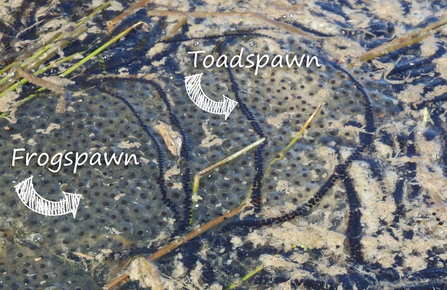
Frogspawn and toadspawn by Wendy Carter
Toads have brown, warty skin and they crawl rather than hop like a frog. Frogs tend to have smoother skin and often have mottled colours with a circle behind the eye (or a stripe through the eye). Whilst frogspawn blooms on the surface of ponds, toadspawn is a little less obvious, laid in strings around aquatic plants.
The triggers for toads and frogs moving to their breeding ponds include temperature, day length and the moon but our changing climate is playing a part in altering when this migration takes place and when spawn is laid. We'd love your help in letting us know when you first see toads, frogs and their spawn so that we can build up a picture of how much earlier this is taking place. We'd also like to know Worcestershire's toad s are doing; at a national level, toad numbers are declining - is that the same here in our county?
House martin
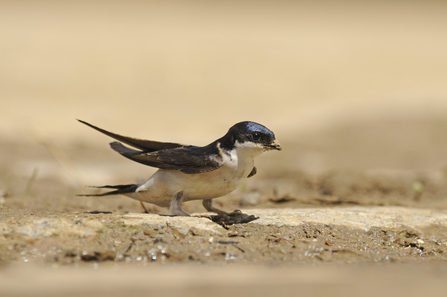
House martin by Dawn Monrose
Although there are a small number of house martins that continue to use natural nests on cliff faces, most of our estimated 480,000 pairs nest below the eaves of our houses and other buildings. Their comings and goings will be familiar to many Worcestershire residents but for those householders who have delighted in their return each year, it may be noticeable that fewer and fewer are making it back each spring. There has been a 57% decline in house martin numbers in the UK between 1969 and 2018 and the species is listed as 'near threatened' globally.
House martins return to the UK in April and stick around until September or October, having two broods (three if the weather is good and they can manage it) but we know that more nests are failing - either nests are collapsing or the young are dying from a shortage of insect food. Recent surveys have shown that newly built nests and those built onto plastic soffits tend to produce only one brood. One way of helping the house martins that nest on your house is to either leave up their old nests or add an artificial nest to give them a boost when they arrive; less energy to build a nest means more energy to raise the next generation. It's estimated that it takes more than 1000 beaks full of mud to build a nest so as well as providing a nest, in dry periods, why not create a muddy patch in your garden to give them something to build and repair their nests with?
It might be tricky to snap a photograph of a house martin in flight to upload via the form below but their white rump should help us to confirm their identification. Alternatively, please take a photograph of their nest/s on your house and submit those instead (or as well). Knowing where house martins are foraging for food as well as where in Worcestershire they are nesting is important to help us understand more about their population. We're also interested in hearing about whether you've noticed a decline in your house martin numbers over the years - did you used to have five or six nests on your house and now you only have one or two?
House sparrow
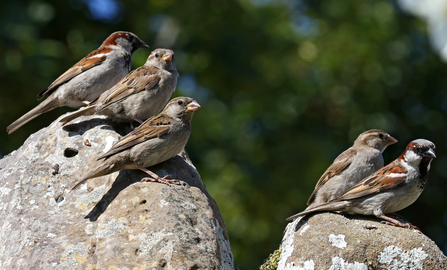
Male and female house sparrows by Wendy Carter
House sparrows were once so common in the midlands that bird reports barely mention them before 1980. However, since 1977 there has been a 71% decline across the UK, including here in Worcestershire.
In Worcestershire, this sociable species (they nest colonially although they have a strict hierarchy) is most often found close to human habitation – in gardens and in hedgerows adjacent to parks and farmland. Fairly sedentary birds, they rarely move more than 2km in their whole life.
House sparrows are primarily seed feeders – their chunky bills are great for crunching through the outer shells of seeds. Garden feeders help to support many populations of house sparrows in areas where habitat may be limited but, like all birds, they’ll search more natural habitats to find food – scrubby fields, hedgerows, dense ivy and bramble patches etc.
Historical records indicate that house sparrows were found in 32% of the county (probably higher – this just reflects what’s been recorded) but in 2020, records submitted covered just 9% of Worcestershire. Most of these records were from urban fringe/suburban areas and there were few from the older and smaller villages where we’d expect the habitat to be suitable.
Are there genuine gaps in the distribution of house sparrows…or have records simply not been submitted? Do we know how well our populations are doing – are they being seen in bumper or dwindling numbers? In 2020 a flock of 104 was seen in Pershore but most reports were for fewer than 20 individuals.
Wherever you are in the county, will you help us to find out where our house sparrows are?
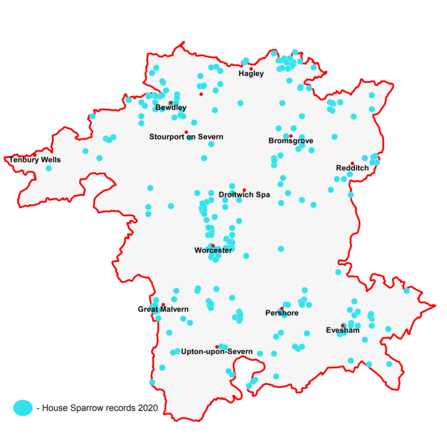
Hummingbird hawk-moth
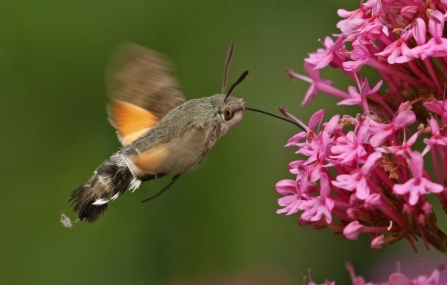
Hummingbird hawk-moth by Wendy Carter
These wonderful day-flying moths take their name from the striking resemblance to hummingbirds as they hover at flowers, using their long proboscis (straw-like tongue) to sup nectar through. Their warm grey/brown bodies, with a black and white tip, and upper wings contrast with the orangey hindwings as they hover at tubular flowers such as viper's-bugloss, red valerian, phlox, jasmine and buddleia. They can be spotted in gardens from June through to October although most records are in August and September. We would love to know if climate change is changing their habits and enabling them to survive our winters.
The reason that most hummingbird hawk-moths are seen so late in the year is that these individuals (615 have been recorded so far in Worcestershire) are immigrants from northern African and southern Europe - it takes a lot of energy from the sun to hover at a flower. Whilst males and females will mate in the UK (their caterpillars can sometimes be found on bedstraws, wild madder and red valerian - they were recorded on lady's bedstraw on Malvern in July 2011, for example), they've not been able to survive our winter. However, in more recent times there has been evidence to show that in southern England, adults have been found hibernating although it's tricky to know whether early sightings are of home-grown adults that have hibernated or early immigrants that have recently flown across the Channel.
It's likely that the peak of hummingbird hawk-moths in August and September is a combination of local and migratory individuals. If you're lucky enough to spot a hummingbird hawk-moth in your flower bed at any time of year, try looking again at the same time the next day. They do something called 'trap-lining' - they learn where and when their favourite flowers are producing nectar in order to return again. Another good place to look is on high points. Like their painted lady butterfly migratory cousins, they often congregate on and around high points (it's known as 'hill-topping'); many of Worcestershire's records are from the top of the Malverns.
Large red damselfly
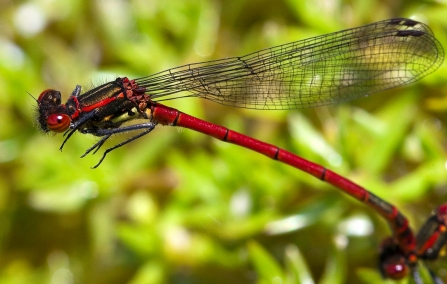
Large red damselfly by Pete Cheshire
Large red damselflies are one of the earliest flying dragonflies and the one that's most likely to be spotted in and around garden ponds. These delicate insects are just 33-36mm long and slimmer than many other damselflies, giving them a rather ethereal quality in flight. They're distinctively red (with a black ring at the tip of the abdomen) and settle with their wings resting along their abdomen. Whilst they're usually a spring and early summer species, the latest Worcestershire record is August.
Amazingly, the adults that we see during summer are already two years old. They spend their first two years as a nymph in slow-moving water or ponds. They are voracious hunters of small aquatic inverterbrates and have mouthparts that shoot out to grab their prey - rather like that of the alien in the famous sci-fi film. When they emerge from the depths and clamber up a vertical stem of vegetation to break out of their nymphal case, it takes them a few hours to develop their red colour - this is known as a teneral stage.
As with many insects, they have compound eyes but unlike their dragonfly cousins, these are comparitively small and set wide apart on their heads. This allows them to see around the grass stems that they often perch on! The bands that can be seen in their eyes are high-resolution areas that help to identify important things like members of the opposite sex or food items.
There is a very rare small red damselfly that is restricted to heathlands in southern England and west Wales so don't worry about confusing the large red with one of this species in Worcestershire.
Mistletoe
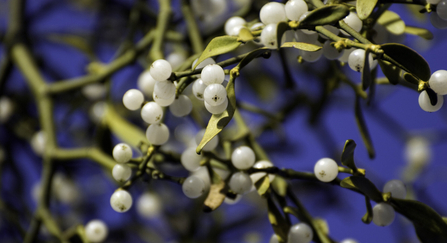
Mistletoe by Zsuzsanna Bird
A plant that is embedded in our folklore and traditions quite unlike any other, mistletoe is regarded as a sign of love and new growth for the coming year. Along with Herefordshire and Gloucestershire, mistletoe is abundant in Worcestershire. Our climate seems to be just right – will this continue to be the case in the face of climate change? Will changes to our temperatures and humidity and rainfall start to change the distribution of this well-known plant?
Mistletoe is only partially parasitic on the host tree. The existence of chlorophyll in its leaves means that, through photosynthesis, it can manufacture sugars from carbon dioxide and water. It steals water and other minerals from the tree, although it doesn’t appear to do the tree any damage. The only time a tree can get stressed is if a branch has huge amounts of mistletoe – it may show signs of wilting as its water and nutrients are removed.
Mistletoe is most frequently spread via birds such as mistle thrush and blackcap who gobble down the berries in winter and then either spread the seeds when they wipe their bills or digest the berries and deposit their seeds in sticky droppings on branches. Mistletoe plants are either male or female but only the female produces the berries.
In Worcestershire, mistletoe has been recorded in nearly 30 species of tree but seems to be most common in fruit trees, hawthorn, poplar and lime. Can you help us to map where it’s found and in what trees – is it found in some trees more often in the north of the county than in the south, for example? Can you find it on oak anywhere?
Mole
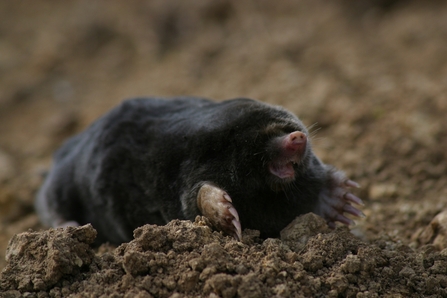
Mole by Steve Bottom
Thanks to The Wind in the Willows by Kenneth Grahame, moles are familiar even though most of us have never seen one. We often only know that moles are present because of their characteristic molehills (for those who are a bit more inquisitive, their bones can be found in owl pellets and fox poo).
These intriguing furry animals are specially designed for a subterranean lifestyle with their tubular bodies and side-facing spade-like front feet with five strong claws for digging. They have pink fleshy snouts that have touch-sensitive receptors, and their faces, front legs and tails have many sensory hairs. Their eyes are minute but functional.
Moles live solitary lives and only overlap territories at mating time. They dig permanent tunnels through which they can move as quickly backwards as they can run forwards. They maintain these tunnels, feeding on invertebrates that fall into them; earthworms are their main prey but they will eat insect larvae, centipedes, millipedes and molluscs.
Sometimes, usually during winter, they build a much larger nest, known as a fortress (up to 1.5m wide and 0.5m tall). This often contains a store of decapitated earthworms - 1200 were found in one larder!
Moles are found in fields, woodland and most places that aren’t waterlogged. If you have moles in your garden, well done for maintaining a healthy worm population! Please try not to worry if they start creating hills – once they’ve settled into their new tunnels, the production of hills should reduce (in the meantime, scrape off the soil to use elsewhere in the garden).
Are they still common? Moles are under-recorded and we’d love to know how they’re doing. Please let us know if you see fresh molehills appearing (or, indeed, if you’re lucky enough to capture a photo of a mole itself).
Red-tailed bumblebee
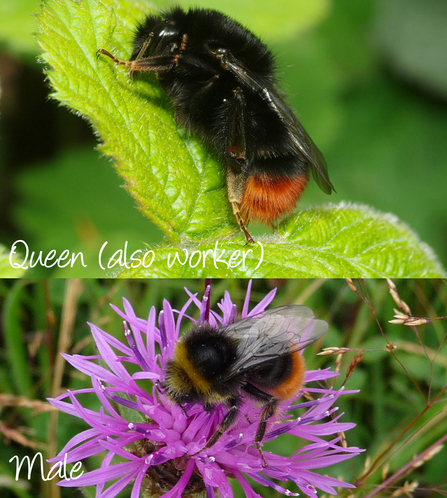
Red-tailed bumblebee - queen/female and male colours by Kevin McGee and Rosemary Winnall
Red-tailed bumblebees are one of our most striking and distinctive species of bee. Queens and workers have a black thorax and abdomen with a red tail that cannot be missed (watch for it fading to orange as the year goes on). Males are much smaller and have a yellow stripe on their thorax as well as a fluffy yellow face.
Red-tailed bumblebees can be found almost anywhere from April to September – gardens, parks, wider countryside – where suitable flowers are available to provide pollen and nectar. Once the queen has chosen a nest site (often an old mouse hole or other underground chamber), she never sees the light of day again. She tends her first offspring but they then take on the role of food-providers and nursemaids while she concentrates on laying eggs.
Red-tailed bumblebees are common across the county but our maps show that there are hotspots. We’d like to know whether this is really the case or whether this reflects where our efforts to record them have been concentrated.
Recent studies have shown that we should be concerned about our pollinators and other wildlife. We know that red-tailed bumblebees have always been common and widespread and we hope that your sightings will help us to discover whether this is still the case. You may think that it’s more important to find out where our rare species are but the distribution and abundance of our common species can indicate the health of our pollinators more generally.
A word of caution when identifying red-tailed bumblebees! If you see a large queen but with dark, almost black, wings this is a red-tailed cuckoo bee. Less common than the true bumblebee, she will take over the nest over a red-tailed bumblebee and lay her own eggs.
7-spot ladybird
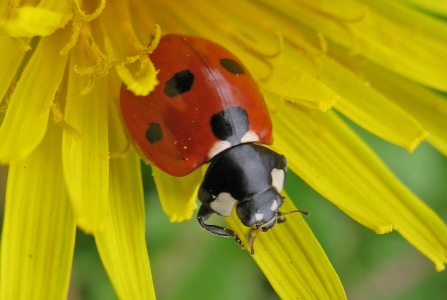
7 spot ladybird by Rachel Scopes
The collective noun for ladybirds is a loveliness and these beautiful beetles are definitely insects that you should be encouraging into your gardens. Along with the marmalade hoverfly, seven spot ladybirds are good friends of gardeners and farmers - both larvae and adults munch aphids and other insects that growers consider to be pests. The adults are easy to identify and live up to their name - count the seven black spots on their red wings, three on each wing case (elytra) and one in the middle straddling both wing cases.
Seven spot ladybirds are one of 45 species of ladybird in the UK, although only 26 of these are species that you'd recognise as obviously ladybirds. The most common native ladybird is the seven spot and its colouring is a warning to potential predators - "steer clear, I'm toxic." In addition to this, when they're disturbed they can pull in their legs and exude a foul-smelling yellow liquid known as reflex blood.
Emerging in spring and heading to the nearest flower to build up their energy by crunching pollen, they soon find mates and lay eggs in the middle of aphid colonies. Their spiky mini-monster-looking larvae (see below) quickly grow as they feast on aphids, before pupating in domed pupal cases. It is not uncommon in midsummer to see more larvae and pupae than adults - if you're able to send us photos of these, it may be possible that we can identify the species.
During winter ladybirds are able to close down their bodies - they find hidden cracks and crevices in which to shelter from the worst of winter's excesses. You may find them in corners of fences and gate posts or they may be buried in leaf litter and hollow stems of plants; it's always worth leaving your garden tidying until the spring (if you can't wait that long, tidy it into a sheltered corner rather than burning it).
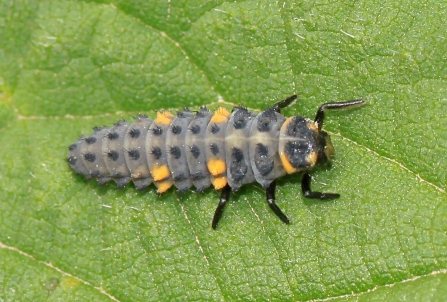
Seven spot ladybird larva by Wendy Carter
Slow-worm
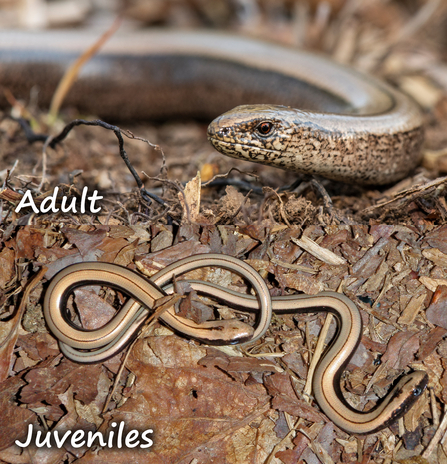
Slow-worms by Matthew Lissimore and Rosemary Winnall
Although resembling small snakes, slow-worms are actually legless lizards with eyelids and the ability to drop their tail in order to escape a predator.
Slow-worms are rarely found basking in the open. They hide away within compost heaps or log piles; a good way of confirming the presence of slow-worms is to place a piece of roofing felt or corrugated tin in a quiet place of a garden or green space and to gently lift it on a warm day to see if slow-worms are warming up underneath it (please replace it very gently). Slow-worms feed on slow-moving prey, particularly small slugs; one allotment holder in Worcester claimed to watch one slow-worm eat 17 slugs before finally wandering off.
Emerging when the weather starts to warm in spring, mating gets underway in late April or May. Males are aggressive towards each other and when courting commences (it can last up to 10 hours), the male takes hold of the female by biting her head or neck before they entwine their bodies. Females incubate their eggs internally and give birth to an average of eight young in late summer.
Slow-worms can grow to 30cm in length and individuals are variable so it can be tricky to tell male from female, especially as they tend to disappear almost as soon as they've been spotted. Males are grey-brown in colour and more mature males often have blue spots along the sides of their bodies whereas females are brown with dark sides (some females have a thin line down the back). Juvenile slow-worms are golden with silver sides and black bellies, often having a stripe that runs the length of the body.
Surveys in the 1990s gave Worcester the nickname 'Slow-worm City' because of the abundance of slow-worms found across the city's allotments. There are still many slow-worms in Worcester's allotments and in gardens and green spaces across the county. We'd love your help in recording slow-worms that you see so that we can confirm that Worcester is still 'Slow-worm City' and to discover whether there are other slow-worm hotspots in Worcestershire or if there are places that slow-worms aren't found.
Slow-worms are protected by law against being deliberately killed, injured or sold/traded in any way.
Small tortoiseshell
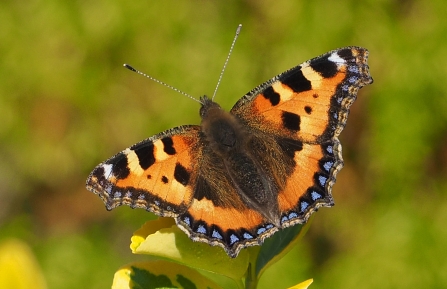
Small tortoiseshell by Pete Smith
The adults of these colourful butterflies overwinter in cellars, sheds, nooks and crannies so they are one of the first butterflies to get up and go as warmer weather breaks the winter cold. Historically, they've been one of the most common butterflies that we see in our nectar-rich gardens. Peak sightings are usually in spring and early autumn when the overwintered or freshly hatched adults are on the wing but look for the caterpillars in patches of nettles during summer months.
Males and females look very similar - orange wings with black markings (a little like tiger-stripes on the leading edge of the forewings), edged with metallic blue spots. Their underwings are dark brown-grey to help camouflage them when they're at rest. Males are territorial and will defend their spot amongst a patch of nettles, sitting with wings open to both attract a mate and to stay warm in order to battle a rival. Their black and spiky caterpillars, with two yellow stripes along their backs, spin a communal web to help protect them against predators; as they move from nettle to nettle, they build webs as they go.
Despite being widespread and common, these beauties of the butterfly world have suffered a 75% decline in the last 40 to 50 years. We're not sure exactly why this is but factors could include habitat loss, climate change and parasites. We would love to have a better understanding of how they're faring in Worcestershire - are their populations following the national decline, have their numbers remained stable or are they bucking the trend?
It's easy enough to help small tortoiseshell and other butterflies by planting nectar-rich flowers in your garden - from dandelions and marjoram to buddleia and sedums, your garden will look great for you and be a haven for wildlife. If you can bring yourself to leave a patch of nettles, you may also play host to a caterpillar creche. An old superstition claims that if an orange butterfly flies near you, joy is on its way - who wouldn't want to help that along?
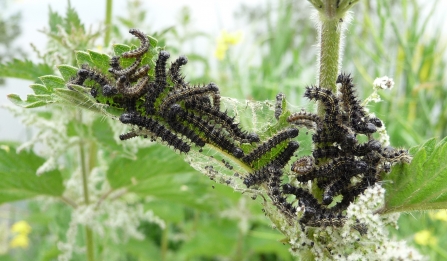
Small tortoiseshell larvae on nettles by Harry Green
See what's been spotted
We're constantly adding verified sightings to our map below. We're prioritising the uploading of 2023's records but please keep coming back as we're updating this regularly.
Please note that records of rare and/or vulnerable species are not included on the map.

